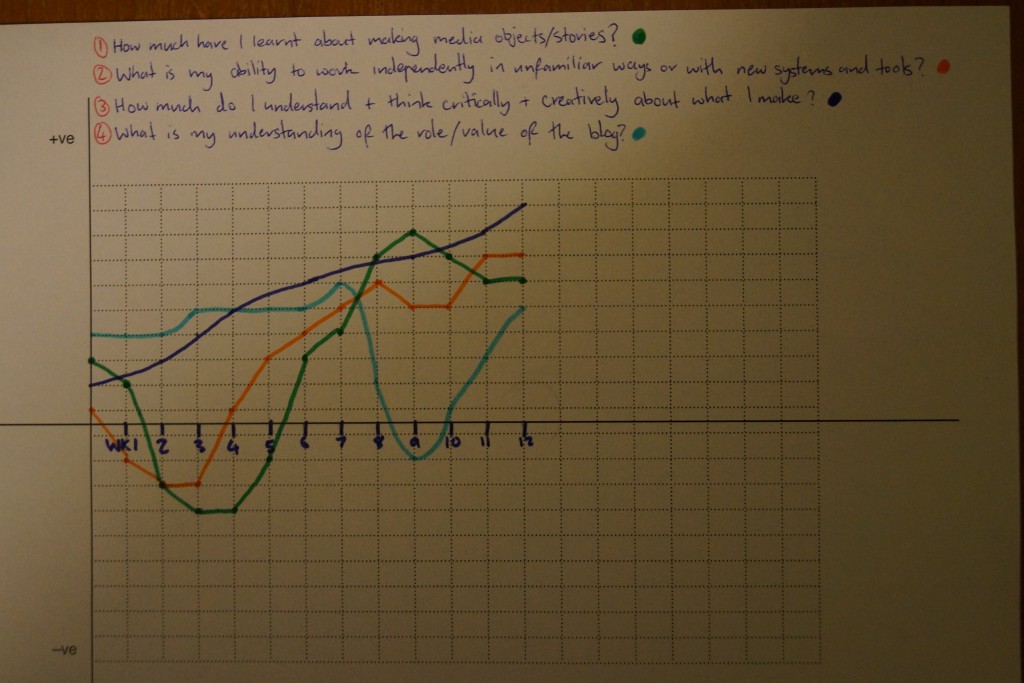After completing one Bachelor’s degree in music already, I was tentative in my approach to start a second degree in media. I wasn’t too sure of what I was getting myself into. Thankfully, cutting the program down by a year put my mind at ease by the time classes began.
For project brief 1 though, I honestly had no idea what I was doing. I was kind of just mashing together ideas in a rush to the deadline. As the semester went on though, I viewed the briefs less as assignments and more as a chance to experiment. Allowing assignments/projects/tasks to breathe by getting on to them early is a major part of my learning thus far. I put more time, effort and thinking time into project briefs 2 and 3 and as a result they were certainly of a higher creative standard than brief 1. Using found footage was a huge eye-opener for me. I really enjoyed sourcing old clips and mixing them with HD material. The contrast in quality made for an appealing retro effect.
In regards to feedback, I have always been a bit reserved when it comes to putting myself out there. Especially creative projects. The collaborative/feedback aspect of this program has been very helpful in creating media. Although it has felt a bit forced, the bouncing around of ideas with other people has greatly contributed to the thought process behind a task. I often feel stuck when I write music and the same happens for when I make a media product. Another person’s input, I have found in this setting is extremely beneficial to the product itself.
The most challenging parts of the course for me so far have been:
- Not having a computer system that could keep up with the demands of the program. My laptop is getting old and slow, and needs a service. Over the break, I am keen to invest in an updated system so I make media more often and productively. This way I can go into semester 2 with a fresh mindset and better knowledge of programs.
- Reading and critiquing scholarly articles. This is something I have always struggled with. I am getting better by the day, but I think the issue is how dry most of the set readings are. My research skills are certainly getting better though as I have been coming across interesting articles more frequently. And to turn a negative into a positive, when these good articles come along, they are captivating.
- Keeping up with blog posts! My opinion of blogging has been a bit of a roller-coaster ride. Looking at my graph, you can see that during the week on Audiences, I questioned the value of the blog. Since then I have realised that it gives me a chance to write and express myself. Regardless of having an audience, it is very good practice.
A visual progression within the course can be found in the graph below:
 My understanding of the blog had its fair share of peaks and troughs. That being said, I consistently enjoyed the freedom to write. Now just to keep it up! The 5 posts that I feel best show my engagement within the course are: Your Retention Please, Sawyer’s Basketball Group Flow, Approaching Media Texts, Who’s My Audience and Remix Culture. Rather than looking at this course as a strict Media degree, I have tried to incorporate past and current knowledge to better my understanding of Media. These five posts thoroughly explore my interests in Psychology, Media, Music, Collaboration, Basketball, Text, Technology and Advertising, and how they intertwine with each other.
My understanding of the blog had its fair share of peaks and troughs. That being said, I consistently enjoyed the freedom to write. Now just to keep it up! The 5 posts that I feel best show my engagement within the course are: Your Retention Please, Sawyer’s Basketball Group Flow, Approaching Media Texts, Who’s My Audience and Remix Culture. Rather than looking at this course as a strict Media degree, I have tried to incorporate past and current knowledge to better my understanding of Media. These five posts thoroughly explore my interests in Psychology, Media, Music, Collaboration, Basketball, Text, Technology and Advertising, and how they intertwine with each other.
– Gabriel